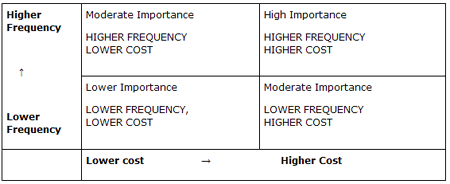Healthcare Cost Data
 What health care cost data can demonstrate
What health care cost data can demonstrate
From the employer’s perspective, increased medical expenditures ultimately translate into higher health insurance premiums for employees and the employer. Therefore, one goal of a workplace health program is to improve employee health, which may result in lower health care expenditures and cost savings for the company.
A review and analysis of health care cost data can be a helpful tool for employers to understand the most common and expensive health conditions where claims have been made; examine trends in costs over time; and compare utilization rates to local, state or national norms. However, not all employers, offer medical care insurance to employees or have the time, resources, or expertise to review and analyze this type of information internally or with external assistance. This may be particularly true for small and medium sized employers. For example, 98% of businesses with 200 or more employees offer health benefits, but only 59% of businesses with less than 200 employees offer these benefits.10 For those employers where a review of health care and pharmaceutical claims data is not feasible or practical, other forms of workplace health assessment such as employee health surveys, environmental assessments or a review of time and attendance data can provide some indication of the health needs, issues, and barriers of employees. This information can provide a foundation from which to plan and implement the workplace health program.
For those who are able to use health care expenditure data, it can be helpful in the development and evaluation of a workplace health program in several ways:
- Analysis of current health care expenditures will inform the company management of the costs of various diseases and conditions. By identifying disease areas that contribute significantly to the total health care costs, results of the analysis can be used to identify areas that should be targeted by an intervention (e.g., diabetes, heart disease). The claims data can also serve as a companion piece to employee self-report data, correlating the reported health needs and behaviors of the workforce
- Analysis of trends in health care expenditures (specifically, pre and post-intervention; changes in the rate of growth over time) will assist with assessing the effects of the health promotion program(s) on employee health and their health expenditures
- Analysis of health care and pharmaceutical claims data can be used for benchmarking to see a) whether the health claims in one worksite are comparable to or differ from claims from other worksites within the same organization; b) how the organization’s health claims compare with other employers doing comparable work; and c) whether there is a pattern of claims that might identify areas of concern in the specific work environment
How to use health care cost data
Data on health claims and health care and pharmaceutical expenditures can be obtained from the company’s health care plan provider(s). Health claims data can be used to identify major sources for health care expenditures by estimating (1) frequency and (2) cost per person treated for various diseases. Combining these two pieces of information will allow for defining the importance of a number of health issues (see figure below).
Importance of Health Issues

[A text description of this chart is also available.]
Limitations/Caveats of health care and pharmaceutical claims
- Review and analysis of health care and pharmaceutical claims data is time and labor intensive. This may be particularly limiting to small and medium sized employers with scarce resources and competing priorities who offer health insurance to their employees. It often takes a considerable amount of time to receive data from a health vendor, and to re-format and analyze this data in an efficient way. The team may also have to analyze data from multiple vendors providing health insurance for employees and the information requested is likely to come in different formats which will have to be reformatted.
- When analyzing trends in health care expenditures, it is important to keep in mind that the effect of a health promotion program may not be reflected in reduced health care expenditures immediately. In fact, it is possible that in the short term, utilization of certain services (e.g., preventive services) will increase resulting in higher health care expenditures. For example, a health promotion program aimed at increased awareness of diabetes and its complications may result in increased utilization of diabetes diagnostic and preventive tests (e.g., blood glucose, eye and foot checks). However, in the long term, an increase of preventive services should reduce or delay development of various diseases, which will, in turn, reduce future health care expenditures. With that in mind, it would be beneficial to analyze trends in health care expenditures for a period longer than one year post intervention
- Careful consideration needs to be given to the period of analysis. Depending on the number of enrollees including employees and dependents in the health plan, data may be aggregated over a two year period rather than examining a single year. In either case, it is important to be sure that all claims for each year under analysis are considered. Some services may be provided during the year of the analysis, but the claims generated from those services may still be outstanding into the first few months of the following year. Be sure to wait to conduct the analysis until all the claims for the year of analysis have been processed
- Analyses of health claims are retrospective in nature. This information describes tests, treatments, and health services that have already been provided to all enrollees. They often do not provide information on employee health behaviors which put employees at risk for developing diseases in the future requiring health care where workplace health programs can have an impact
- The usefulness of health care claims analyses can be complicated by incomplete health claims, unreliable or invalid coding, and missing information, such as important clinical variables. Diagnoses are often listed in the medical record; however, the principal diagnoses may not be cited accurately when the health claim is filed
- The effective management of data available presents another limitation. There are hundreds of International Disease Classification (ICD-10) codes and analyzing them all would take considerable time and resources. Focus on codes associated with the most common chronic conditions or codes associated with prevalent employee health issues from information gathered through employee self-report surveys. More detailed analysis could include looking at specific classes of drugs such as anti-hypertensives that employees are being prescribed to get a sense of patient compliance and the degree to which patients have their disease under control
- The strategic application of the coding process is a critical determinant for identifying the reimbursement rate of institutional and professional services. Physicians are often reimbursed at higher rates for diagnostics and treatment procedures than they are for routine preventive service visits. Consequently, routine preventive services, such as general physical examinations, may be underestimated because of the reimbursement structure for the procedure
- Because claims are generated for billing purposes, they do not include information about severity or duration of disease or illness. Consequently, this type of analysis would not compare the health outcomes of employees with like illnesses
- Lastly, it is vital to maintain confidentiality and privacy when handling health claims. As a health consumer, each employee is guaranteed certain rights in terms of their medical records. Make sure to handle records carefully and securely. All data analysis should abide by Health Insurance Portability and Accountability Act (HIPAA)
- Page last reviewed: December 8, 2015
- Page last updated: December 8, 2015
- Content Source:


 ShareCompartir
ShareCompartir